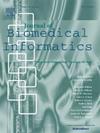揭示数字过度诊断-使用临床轨迹的量化和缓解:肝素诱导的血小板减少用例。
IF 4.5
2区 医学
Q2 COMPUTER SCIENCE, INTERDISCIPLINARY APPLICATIONS
引用次数: 0
摘要
目的:当符合诊断标准的异常在未诊断的情况下仍无症状时,就会出现过度诊断。最初通过数字诊断工具确定但后来被认定为过度诊断的病例被称为“数字过度诊断”。量化和减轻过度诊断的数据驱动框架仍然有限。本研究引入了一个框架,该框架整合了临床轨迹,以训练基于机器学习(ML)的疾病分类器,以肝素诱导的血小板减少症(HIT)为案例研究,实现了数字过度诊断的量化和缓解。方法:预先存在的HIT分类器识别HIT阳性和HIT阴性病例,基于HIT诊断标准的基本事实。使用基于过程模型的新方法对真阳性(TP)和真阴性(TN)患者的临床轨迹进行聚类。当TP病例与主要TN病例聚集时,发现过度诊断。然后用整合HIT标准和一致轨迹的“更新标签”重新训练分类器,以减少过度诊断,同时保持准确性。结果:7.2%的TP病例被诊断为过度诊断。使用更新后的标签进行再训练,成功地将89.5%的过度诊断病例重新分类为TN,而性能仅略有下降(MCC下降0.03,阳性似然比下降0.49,阴性似然比增加0.05)。临床结果——住院时间、血栓形成事件和死亡率——在非过度诊断病例和过度诊断病例之间,以及在非过度诊断病例和TN病例之间存在显著差异,但在过度诊断病例和TN病例之间没有差异,这证实了过度诊断患者与TN患者相似。结论:将临床轨迹纳入基于ml的诊断可以量化数字化过度诊断。这种方法可以通过在监督学习中提示对基于标准的疾病标签的重新评估来改进ML算法。本文章由计算机程序翻译,如有差异,请以英文原文为准。

Uncovering digital overdiagnosis – Quantification and mitigation using clinical trajectories: Heparin-induced thrombocytopenia use case
Objective
Overdiagnosis occurs when abnormalities meeting diagnostic criteria would remain asymptomatic if undiagnosed. Cases initially identified through digital diagnostic tools but later recognised as overdiagnosis are referred to as ‘digital overdiagnosis’. Data-driven frameworks to quantify and mitigate overdiagnosis remain limited. This study introduces a framework that integrates clinical trajectories to train a machine learning (ML)-based disease classifier, enabling the quantification and mitigation of digital overdiagnosis, using Heparin-Induced Thrombocytopenia (HIT) as a case study.
Methods
A pre-existing HIT classifier identified HIT-positive and HIT-negative cases, with ground truth based on HIT diagnostic criteria. Clinical trajectories for True Positive (TP) and True Negative (TN) patients were clustered using a novel process-models-based approach. Overdiagnosis was detected when TP cases clustered with predominantly TN cases. The classifier was then retrained with an ‘updated label’ integrating both HIT criteria and the concordant trajectory, to reduce overdiagnosis while maintaining accuracy.
Results
7.2% of TP cases were identified as overdiagnosed. Retraining with the updated labels successfully reclassified 89.5% of overdiagnosed cases as TN, with only a minimal reduction in performance (MCC decreased by 0.03, positive likelihood ratio decreased by 0.49, and negative likelihood ratio increased by 0.05). Clinical outcomes—length of stay, thrombotic events, and mortality—differed significantly between non-overdiagnosed and overdiagnosed cases, and between non-overdiagnosed and TN cases, but not between overdiagnosed and TN cases, confirming that overdiagnosed patients resemble TN patients.
Conclusion
Incorporating clinical trajectories into ML-based diagnosis enables the quantification of digital overdiagnosis. This approach could refine ML algorithms by prompting a reassessment of criteria-based disease labels in supervised learning.
求助全文
通过发布文献求助,成功后即可免费获取论文全文。
去求助
来源期刊

Journal of Biomedical Informatics
医学-计算机:跨学科应用
CiteScore
8.90
自引率
6.70%
发文量
243
审稿时长
32 days
期刊介绍:
The Journal of Biomedical Informatics reflects a commitment to high-quality original research papers, reviews, and commentaries in the area of biomedical informatics methodology. Although we publish articles motivated by applications in the biomedical sciences (for example, clinical medicine, health care, population health, and translational bioinformatics), the journal emphasizes reports of new methodologies and techniques that have general applicability and that form the basis for the evolving science of biomedical informatics. Articles on medical devices; evaluations of implemented systems (including clinical trials of information technologies); or papers that provide insight into a biological process, a specific disease, or treatment options would generally be more suitable for publication in other venues. Papers on applications of signal processing and image analysis are often more suitable for biomedical engineering journals or other informatics journals, although we do publish papers that emphasize the information management and knowledge representation/modeling issues that arise in the storage and use of biological signals and images. System descriptions are welcome if they illustrate and substantiate the underlying methodology that is the principal focus of the report and an effort is made to address the generalizability and/or range of application of that methodology. Note also that, given the international nature of JBI, papers that deal with specific languages other than English, or with country-specific health systems or approaches, are acceptable for JBI only if they offer generalizable lessons that are relevant to the broad JBI readership, regardless of their country, language, culture, or health system.
 求助内容:
求助内容: 应助结果提醒方式:
应助结果提醒方式:


